Italo-Albanian Catholic Church
The Italo-Albanian Catholic Church (Italian: Chiesa cattolica Italo-Albanese;[3] Albanian: Kisha Bizantine Arbëreshe), Italo-Albanian Byzantine Catholic Church[4] or Italo-Albanian Church, is one of the 23 Eastern Catholic Churches which, together with the Latin Church, compose the Catholic Church. It is a particular church that is autonomous (sui juris), using the Byzantine Rite and the ancient Greek language (the language that was the principal of all peoples in the tradition of the Eastern Churches) or the Albanian language (the mother language of the community) for the liturgy, whose Italo-Albanian (Arbëreshë) members are concentrated in Southern Italy (Abruzzo, Apulia, Basilicata, Calabria), and Sicily.
| Italo-Albanian Byzantine Catholic Church | |
|---|---|
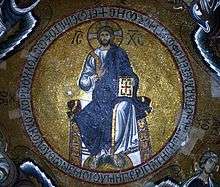 | |
| Classification | Eastern Catholic |
| Polity | Episcopal |
| Governance | Synod |
| Structure | Tri-ordinariate |
| Pope | Francis |
| Leader |
|
| Associations | Congregation for the Oriental Churches |
| Region | Rome, Southern Italy, Sicily |
| Liturgy | Byzantine Rite |
| Origin | 2 June 1784: Ordinariate of Silicia appointed[1] |
| Branched from | Catholic Church |
| Congregations | 45 |
| Members | 61,487 |
| Ministers | 82 priests, 5 deacons[2] |
| Other name(s) |
|
| Official website | |
| Part of a series on |
| Particular churches sui iuris of the Catholic Church |
|---|
Latin cross and Byzantine Patriarchal cross |
| Particular churches are grouped by rite. |
| Alexandrian Rite |
| Armenian Rite |
| Byzantine Rite |
| East Syriac Rite |
| Latin liturgical rites |
| West Syriac Rite |
|
|
| Part of a series on |
| Albanians |
|---|
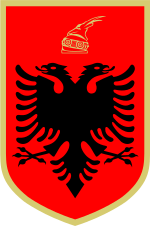 |
| By country |
|
Native Albania · Kosovo Croatia · Greece · Italy · Montenegro · North Macedonia · Serbia Diaspora Australia · Bulgaria · Denmark · Egypt · Finland · Germany · Norway · Romania · South America · Spain · Sweden · Switzerland · Turkey · Ukraine · United Kingdom · United States |
| Culture |
| Architecture · Art · Cuisine · Dance · Dress · Literature · Music · Mythology · Politics · Religion · Symbols · Traditions · Fis |
| Religion |
| Christianity (Catholicism · Orthodoxy · Protestantism) · Islam (Sunnism · Bektashism) · Judaism |
| Languages and dialects |
|
Albanian Gheg (Arbanasi · Upper Reka dialect · Istrian) · Tosk (Arbëresh · Arvanitika · Calabria Arbëresh · Cham · Lab) |
| History of Albania |
The Italo-Albanian Church is in full communion with the Pope of Rome, directly subject to the Roman Congregation for the Oriental Churches, but follows the ritual and spiritual traditions that are common in most of the Eastern Orthodox Church. Church members are the descendants of the exiled Albanians who fled to Italy in the 15th century under the pressure of the Turkish persecutions in Albania and the territories inhabited by Albanians in the Balkans and the Peloponnese. The Albanian population in Italy has maintained until today the language, customs and religious rites of their origin. This Church maintains their heritage, the ethnic, cultural and religious tradition of the Albanians fathers, keeping alive the spiritual and liturgical tradition of the Eastern Church from the time of Justinian (6th century).
Name
The Byzantine rite was brought to Italy in the 15th century by Albanian exiles fleeing from Albania, Epirus and Morea because of persecution by Ottoman Turks of Muslim faith. Italy had already known Eastern Christian rites in previous centuries, but these had since disappeared. The Albanians, Orthodox united in Rome with the Council of Ferrara-Florence, brought with them language, customs, customs and belief, jealously keeping the Byzantine rite and naturally bridging between East and West (see Albanian missions in Albania in 1690-1769, contacts with Ohrid, Cretan Byzantine art and new missions of re-Christianization of Albania in 1900[5]).
The Italo-Albanian Catholic Church Is therefore characterized by a specific ethnic group: the Albanians of Italy, Arbëreshë or Italo-Albanesi.
The only place where the Byzantine Rite remained in Italy was the Monastery of Grottaferrata, an Italo-Greek foundation, which had become steadily latinized through the centuries. The Albanians of Sicily and Calabria, from the eighteenth to the present, were bringing the monastery back to life, where most of its monks, abbots and students were and are Italo-Albanian, began to once again flourish.[6]
The name "Greek" refers to the Byzantine Rite (as opposed to "Latin" Roman Rite) and not to an ethnic component.
History
Byzantine period
The conquest of Italy by the Byzantine Empire in the Gothic War (535–554) began a Byzantine period that included the Byzantine domination of the Papacy from 537 to 752.
It is uncertain whether the Byzantine Rite was followed in any diocese of Southern Italy or Sicily before the 8th century. The spread of Greek monasticism in Italy received a strong impulse from the Rashidun Caliphate invasion of the Levant and Egypt, and later from the ban on religious images or icons. The monks naturally retained their rite, and as the bishops were not infrequently chosen from their number, the diocesan liturgy, under favourable conditions, could easily be changed, especially since the Lombard occupation of the inland regions of Southern Italy cut off the Greeks in the South from communication with the Latin Church.[6]
When, in 726, Leo III the Isaurian withdrew Southern Italy from the patriarchal jurisdiction of Rome and gave it to the Patriarch of Constantinople, the process of hellenization became more rapid; it received a further impulse when, on account of the Muslim conquest of Sicily, Greeks and Hellenized Sicilians fled to Calabria and Apulia. Still it was not rapid enough to suit the Byzantine emperors, who feared lest those regions should again fall under the influence of the West, like the Duchy of Rome and the Exarchate of Ravenna. Finally, after the Saxon emperors had made a formidable attempt to drive the Greeks from the peninsula, Emperor Nikephoros II Phokas and the Patriarch Polyeuctus made it obligatory on the bishops, in 968, to adopt the Byzantine Rite. This order aroused lively opposition in some quarters, as at Bari, under Bishop Giovanni. Nor was it executed in other places immediately and universally. Cassano and Taranto, for instance, are said to have always maintained the Roman Rite. At Trani, in 983, Bishop Rodostamo was allowed to retain the Roman Rite, as a reward for aiding in the surrender of the city to the Greeks. In every diocese there were always some churches which never forsook the Roman Rite; on the other hand, long after the restoration of that rite, there remained Greek churches with native Greek clergy.[6]
Re-Latinization
The restoration of the Roman Rite began with the Norman conquest in the 11th century, especially in the first period of the conquest, when Norman ecclesiastics were appointed bishops. Another potent factor was the reform of Pope Gregory VII, who in his efforts to repress marriage among the Latin clergy found no small obstacle in the example of the Greek priests. However, he and his successors recognized the Byzantine Rite and discipline wherever it was in legitimate possession. Moreover, the Latin bishops ordained the Greek as well as the Latin clergy. In the course of time the Norman princes gained the affection of their Greek subjects by respecting their rite, which had a strong support in the numerous Basilian monasteries (in the 15th century there were still seven of them in the Archdiocese of Rossano alone). The latinization of the dioceses was complete in the 16th century. Among those which held out longest for the Byzantine Rite were Acerenza (and perhaps Gravina), 1302; Gerace, 1467; Oppido, 1472 (when it was temporarily united to Gerace); Rossano, 1460; Gallipoli, 1513; Bova (to the time of Gregory XIII), etc. But even after that time many Greek priests remained in some dioceses. In that of Otranto, in 1583, there were still two hundred Greek priests, nearly all native. At Reggio, Calabria, Count Ruggiero in 1092 had given the Greeks the church of S. Maria della Cattolica, whose clergy had a Protopope, exempt from the jurisdiction of the bishop; this was the case until 1611. In 1695 there were in the same dioceses fifty-nine Greek priests; after thirty years there was only one. Rossano still had a Greek clergy in the 17th century. The few native Greek priests were afterwards absorbed in the tide of immigration (see below). Of the Basilian monasteries the only one left is that of Grottaferrata, near Rome. In Sicily the latinization was, for two reasons, accomplished more easily and radically. First, during the rule of the Muslim most of the dioceses were left without bishops, so that the installation of Latin bishops encountered no difficulty; secondly, the Normans had come as liberators, and not as conquerors.[6]
Important Greek colonies, founded chiefly for commercial reasons, were located at Venice, Ancona (where they obtained from Clement VII and Paul III the church of S. Anna, which they lost in 1833, having been declared schismatical in 1797), Bari, Lecce (where, even in the 19th century, in the church of S. Nicola, Divine worship was carried on in the Greek tongue, though in the Roman Rite), Naples (where they have the church of SS. Pietro e Paolo, erected in 1526 by Tommaso Paleologo Assagni), Leghorn (where they have the church of the Annunziata, 1607).[6]
In Rome there was always a large colony observing the Greek Rite. From the end of the 6th century until the ninth and tenth there were several Greek monasteries among which were Cella Nova, near S. Saba; S. Erasmo; San Silvestro in Capite; the monastery next to Santa Maria Antiqua at the foot of the Palatine. Like other nations, the Greeks before the year 1000 had their own schola at Rome. It was near the church of Santa Maria in Cosmedin. Even in the pontifical liturgy - at least on some occasions - a few of the chanted passages were in Greek: the custom of singing the Epistle and Gospel in both Latin and Greek dates from that period.[6]
Albanian influx
Besides the first large emigration of Albanians which took place between 1467 and 1470, after the death of the celebrated George Castriota Scanderbeg (when his daughter, who had become the Princess of Bisignano, invited her countrymen to the Kingdom of Naples), there were two others, one under Ottoman Empire Sultan Selim II (1566–1574), directed to the ports along the Adriatic Sea and to Livorno; the other about 1740. In the course of time, owing to assimilation with the surrounding population, the number of these Italo-Greeks diminished, and not a few of their villages became entirely Latin.[6]
To educate the clergy of these Greeks, Pope Gregory XIII founded in 1577 at Rome the Greek College of St. Athanasius, which served also for the Greek Catholics of the East and for the Ruthenians, until a special college was instituted for the latter purpose by Pope Leo XIII. Among the alumni of St. Athanasius was the celebrated Leo Allatius. Another Greek-Byzantine ecclesiastical college was founded at Piana degli Albanesi in 1715 by P. Giorgio Guzzetta, founder of an Oratory of celibate Greek-Byzantine clergy. At Firmo the seminary of SS. Pietro e Paolo existed from 1663, erected by the Propaganda to supply priests for Albania. It was suppressed in 1746. Finally Pope Clement XII, in 1736, founded the Corsini College in the ancient Abbey of San Benedetto Ullano in the charge of a resident bishop or archbishop of the Greek Rite. Later it was transferred in 1794 to San Demetrio Corone, in the ancient Basilian monastery of S. Adriano. Since 1849, however, and especially since 1860, this college has lost its ecclesiastical character and is now secularized.[6]
Seminaries for the Albanians of Italy were set up in San Benedetto Ullano, and then in San Demetrio Corone, (Calabria) in 1732 and in Palermo, Sicily, in 1734.[7]
Ecclesiastical status
Until 1919, the Italo-Greeks were subject to the jurisdiction of the Latin diocesan bishops. However, the popes at times appointed a titular archbishop, resident in Rome, for the ordination of their priests. When Clement XII established the Corsini College at San Benedetto Ullano in 1736, he placed it in charge of a resident bishop or archbishop of the Greek Rite. Pope Benedict XIV, in the papal Bull "Etsi pastoralis" (1742), collected, co-ordinated and completed the various enactments of his predecessors, and this Bull was still law in 1910, regulating the transfer of clergy and lay people between the communities of the Greek Church and Latin Church, and specifying that children of mixed marriages would be subject to the Latin Church.[6]
Sui juris
On 6 February 1784, the pre-diocesan Ordinariate of the Albanians in Sicily was created, with Bishop Papàs Giorgio Stassi, titular Bishop of Lampsacus, first holding that position.[1]
By 1909, another Ordinary for the Greeks of Calabria was residing at Naples.[6]
The 20th century saw the foundation in 1919 of the Eparchy of Lungro (an Eastern Catholic bishopric) in Calabria,[8] which serves Byzantine-Rite Albanians in mainland Italy, and on 26 October 1937 of the Eparchy of Piana dei Greci for those in Sicily promoted from the Ordinariate of Sicilia.[1] One month before the foundation of the Eparchy of Piana dei Greci in 1937, the Byzantine-Rite Monastery of Saint Mary of Grottaferrata, not far from Rome, was given the status of a territorial abbacy, separating it from the jurisdiction of the local bishop.[9] In October 1940, the three ordinaries held an inter-eparchial synod for preserving their Byzantine traditions and unity with an Orthodox Church of Albania observation delegation.[7] On 25 October 1941, the Eparchy of Piana dei Greci was renamed as the Eparchy of Piana degli Abanesi /Eparhia e Horës së Arbëreshëvet.[1]
In 2004 and 2005, a second inter-eparchial synod was held in three sessions approving 10 documents for "the synod’s theological and pastoral context, the use of Scripture, catechesis, liturgy, formation of clergy, canon law, ecumenical and interreligious relations, relations with other Eastern Catholic Churches, re-evangelization and mission." They were submitted to the Holy See and were still in dialogue as of mid-2007 in regards to their promulgation.[10]
Organisation
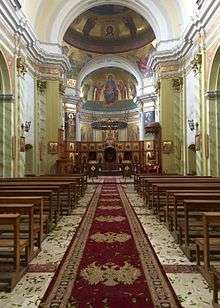
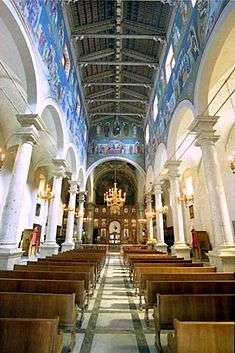
There are three ecclesiastical jurisdictions composing the Italo-Albanian Catholic Church:
- Eparchy of Lungro degli Italo-Albanesi
- Eparchy of Piana degli Albanesi
- Territorial Abbacy of Santa Maria of Grottaferrata[11]
The eparchies themselves have not been organized as a Metropolitan church, and remain on an equal footing, directly subject to the Holy See.[1][8][9] These eparchies allow the ordination of married men as priests, and they also govern a few Latin Church parishes within the respective territories of the eparchies.
As of 2010, the church's membership was estimated at approximately 61,000 faithful, with two bishops, 45 parishes, 82 priests, 5 deacons, and 207 religious brothers and sisters.[2]
In the church there are the following religious institutions: the Italo-Albanian Basilian Monks Order of Grottaferrata (present in Lazio, Calabria and Sicily), the Suore Collegine della Sacra Famiglia, and the congregation of the Italo-Albanian Basilian Sisters Figlie di Santa Macrina (present in Sicily, Calabria, Albania and Kosovo).
Italo-Albanian communities were formed in the cities of Milan, Turin, Rome, Naples, Bari, Lecce, Crotone, Cosenza and Palermo, as well as in Switzerland, Germany, United States, Canada, Argentina and Brazil. They depend, however, on Latin dioceses and only in some cases is the Byzantine liturgy celebrated. Over the centuries, albeit limited, there have been contacts religious between Albanians of Italy with the Christian East (monasteries of Crete) and Albania (Archdiocese of Shkodër, Durrës, Himarë). Important is the spiritual and cultural contribution of the monks and ieromonaci Albanians in the monastery of Grottaferrata.
Outside of Italy there are some diaspora communities Italo-Albanian organized in religious associations and parishes.
In the United States there are other churches of the Byzantine Rite (for example Our Lady of Wisdom Church in Las Vegas, under the jurisdiction of the Byzantine Catholic Eparchy of Phoenix,[12] and Italo-Greek Catholic Mission of Our Lady of Grace in New York,[10] under the jurisdiction of the Roman Catholic Archdiocese of New York.[13]) and more generally of the Eastern rite or different ethno-linguistic and historical tradition.
Territorial Abbacy of Saint Mary of Grottaferrata
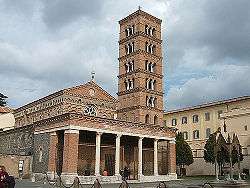
Territorial Abbacy of Saint Mary of Grottaferrata Beatissimæ Mariæ Cryptæferratæ [9] Santa Maria di Grottaferrata | |
|---|---|
| Location | |
| Country | Italy |
| Ecclesiastical province | Holy See[9] |
| Statistics | |
| Parishes | 1 |
| Churches | 1 |
| Schools | 1 |
| Members | 87[2] |
| Information | |
| Denomination | Italo-Albanian Catholic Church |
| Rite | Byzantine Rite |
| Established | 1937[9] |
| Cathedral | Exarchial Monastery of St. Mary of Grottaferrata[14] |
| Patron saint | Nilo da Rossano[9] |
| Secular priests | 10 |
| Current leadership | |
| Pope | Francis |
| Abbot Ordinary[9] | Sede Vacante |
| Apostolic Administrator | Marcello Semeraro |
| Website | |
| abbaziagreca.it | |
The Territorial Abbacy of Santa Maria of Grottaferrata is the only Italian Basilian Order of Grottaferrata monastery and is stauropegic and is the only remnant of the once-flourishing Italo-Greek monastic tradition. The Italo-Albanian Basilian Order of Grottaferrata (abbreviated as O.S.B.I.) is the religious order of the Italo-Albanian Catholic Church. It is located in Grottaferrata, Rome, Lazio, Italy. The abbott ordinary is also the superior general of the Italian Basilian Order of Grottaferrata.[9]
There is a rectory church in Rome, Saint Basil at the Sallust Gardens, that the Territorial Abbey operates.[15]
- History
The abbey was founded in 1004[16] by Nilus of Rossano, a monk of Greek descent from Calabria, and has remained in continuous operation since then. It is the only one of the Italo-Greek monasteries that has survived. Most gradually fell into decadence and were taken by the Kingdom of Italy when it secularized religious orders in 1866. Only the Grottaferrata monastery, considered a national monument, was allowed to continue with the monks as its guardians. In the course of time, the civil authorities have allowed them increasing independence.
Abbot Apolemone Agreste had a church, Saint Basil at the Sallust Gardens build on St. Basil Street, Rome. Attached to it was a hospice.[17]
In 1880 the Holy See ordered the liturgy of the monastery to be purged of the Latin elements that had been introduced over the centuries. Vocations were no longer sought from the general Italian population, but instead chiefly among Italo-Albanians, and the monks set up new monasteries in Sicily and Calabria. On 1 November 1571, the Italian Basilian Order of Grottaferrata was established.[18] On 26 September 1937, the abbey was made a territorial abbacy).[9] The Church of St. Basil was restored to the order in 1682.[17]
See also
- Albanian Byzantine Catholic Church
- Arbëreshë people
Further reading
- Oriente Cattolico (Vatican City: The Sacred Congregation for the Eastern Churches, 1974)
- Fortescue, Adrian. The Uniate Eastern Churches: the Byzantine Rite in Italy, Sicily, Syria and Egypt. Ed. George D. Smith. New York: F. Ungar, 1923. Print.
References
- "Diocese of Piana degli Abanesi". GCatholic.org. Retrieved 27 December 2011.
- Ronald Roberson. "The Eastern Catholic Churches 2010" (PDF). Catholic Near East Welfare Association. Archived from the original (PDF) on 23 September 2015. Retrieved December 2010. Check date values in:
|accessdate=(help) Information sourced from Annuario Pontificio 2010 edition - "Italo-Albanese Catholic Church of the Byzantine Tradition". catholic-hierarchy.org. Retrieved 2 July 2017.
- "Italo-Albanese Church. Eastern-Rite sui juris Catholic Church. Italy : Lungro, Piana degli Albanesi, Santa Maria di Grottaferrata". gcatholic.org. Retrieved 2 July 2017.
- Ines Angjeli Murzak, Returning Home to Rome: The Basilian Monks of Grottaferrata in Albania, Grottaferrata 2009
- Herbermann, Charles, ed. (1913). . Catholic Encyclopedia. New York: Robert Appleton Company.
- Roberson, Ronald G. "The Italo-Albanian Catholic Church. Page 1". The Eastern Christian Churches: A Brief Survey. Catholic Near East Welfare Association. Retrieved 27 December 2011.
- "Diocese of Lungro". GCatholic.orgs. Retrieved 27 December 2011.
- "Territorial Abbacy of Santa Maria di Grottaferrata". GCatholic.orgs. Retrieved 27 December 2011.
- Roberson, Ronald G. "The Italo-Albanian Catholic Church. Page 2". The Eastern Christian Churches: A Brief Survey. Catholic Near East Welfare Association. Retrieved 27 December 2011.
- "Italo-Albanese Church". GCatholic.orgs. Retrieved 27 December 2011.
- "Our Lady of Wisdom Italo-Greek Byzantine". Eastern & Oriental Catholic Directory. ByzCath.org. Archived from the original on 3 June 2012. Retrieved 28 December 2011.
- "Our Lady of Grace Greek-Catholic Mission & Society (Italo-Graeco-Albanian)". Eastern & Oriental Catholic Directory. byzcath.org. Archived from the original on 3 June 2012. Retrieved 28 December 2011.
- "Exarchial Monastery of St. Mary of Grottaferrata". GCatholic.org. Retrieved 28 December 2011.
- "Chiesa di San Basilio agli Orti Sallustiani". GCatholic. Retrieved 6 July 2020.
- Pettifer, James; Nazarko, Mentor (1 January 2007). Strengthening Religious Tolerance for a Secure Civil Society in Albania and the Southern Balkans. IOS Press. ISBN 9781586037796.
- M. Armellini, Le chiese di Roma dal secolo IV al XIX, pp. 271-272. Roma 1891.
- "Italian Basilian Order of Grottaferrata". Religious Orders. GCatholic.org. Retrieved 3 January 2012.